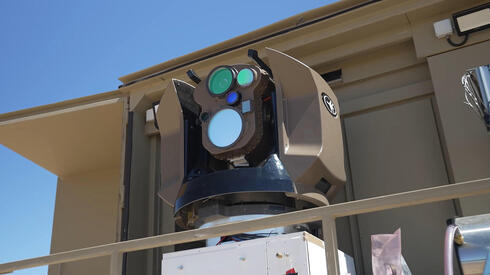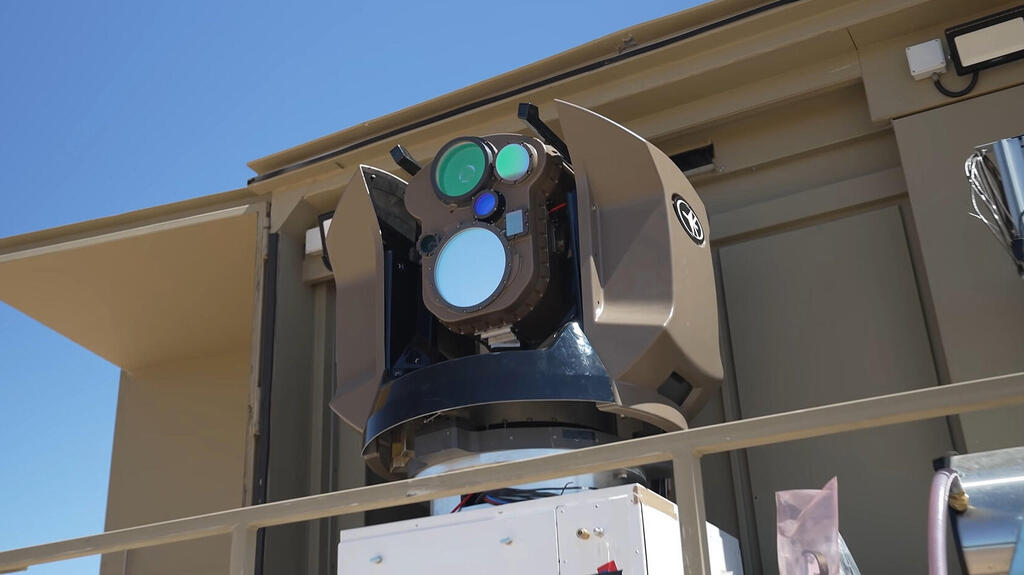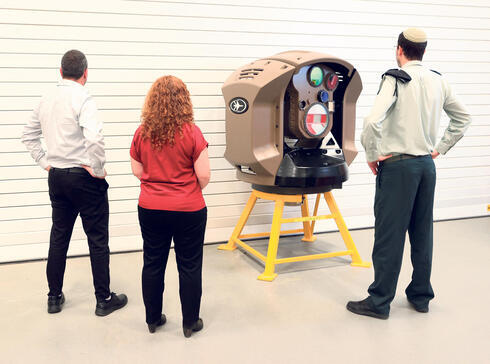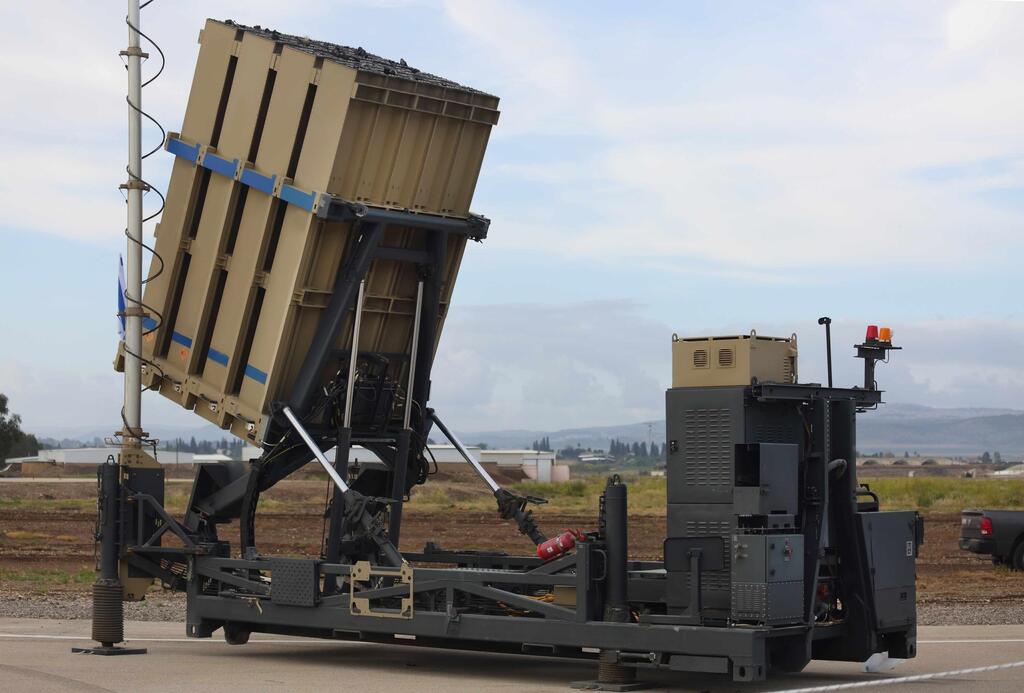
ISRAEL AT WAR
Iron Beam laser defense system set to become operational earlier than expected
The security establishment sees the war in Gaza as an opportunity to test Rafael's laser interception system in the hope of making it operational as early as next year. At the same time, Rafael and IAI are accelerating the development of systems that should provide multi-layered protection from space as well
The missiles, rockets and drones launched at Israel by Hamas, Hezbollah, the pro-Iranian militias in Syria and the Houthis in Yemen have been intercepted by a series of different defense systems that communicate with each other, coordinate and distribute interception missions in real time. Israel has invested billions of dollars to establish this multi-layered defense system over the past 15 years.
Israel entered the Gaza campaign with the most developed defense system in the world against missiles and rockets capable of detecting and intercepting mortar bombs launched at short ranges of a few kilometers to long-range ballistic missiles with enormous warheads weighing about half a ton.
The future of the systems, which will be based in part on the lessons of the current war, will include a significant expansion to this array, with at least three new interception systems in the development stages. The most intriguing and groundbreaking of them all is Rafael's "Iron Beam" which is designed to intercept rockets, anti-tank missiles, drones and mortars using a powerful laser.
More than a hundred engineers from Rafael's Research, Development and Engineering division are working on accelerating the development of Iron Beam. For 17 years, a pioneering team led by engineer Dr. Yohai has been working on the development of the system that should allow the interception of short-range targets in flight at the speed of light, with a cartridge that never ends and at almost zero cost.
After many years of trial and error, in recent years Rafael's development team recorded a series of technological achievements that led at the beginning of the year to the deployment of Iron Beam in an experimental area in the Negev to test its capabilities in real world conditions.
The results of the experiment were satisfactory, with Iron Beam successfully dealing with barrages of rockets, mortar bombs and also with an unmanned aircraft that fell to the ground after the laser beam "cooked" one of its wings and turned it from a potential threat into a piece of junk that dove into the desert soil from a high altitude.
At the heart of the system is an electric laser aimer that focuses on a defined target and fires a beam with a power of about 100 kilowatts and a diameter of a coin. The laser beam is hidden from view, both during the day and at night, and can only be seen through devices that are intended for this.
Silent, but deadly
It is silent, so that a launch at the target is not accompanied by the thunder of the departure of interceptor missiles, similar to the existing defense systems. Its interceptions are also quiet and free of explosions. In fact, the only noise from the laser interceptor comes from the generator that supplies the electricity needed to produce the deadly beam.
With the beginning of the war in Gaza, during which more than 10,000 rockets and missiles have been launched towards the Israeli home front, Rafael and the Ministry of Defense decided to use this as an opportunity to test Iron Beam’s systems under real field conditions in the hope that the results of this operational test may significantly shorten its development process. The security establishment has remained silent regarding the planned experiment.
Iron Beam is intended for first operational deployment during 2025, but it is possible that it will be deployed in the field much earlier, as Rafael is accelerating its development and trying to bring it to initial operation as early as next year. At least in the first phase, it will be a complementary component that will be added to the Iron Dome system, and the decision whether to launch an interceptor missile that costs about $50,000 or a laser beam that costs a few shekels at a rocket or mortar will be based on conditions in the field. On days with clouds, fog and sandstorms it will be difficult to trust Iron Beam, whose activity is limited in such situations, and interception will be led by Iron Dome.
In the first comprehensive interview that Calcalist published last April with the developers of Iron Beam in Rafael, one of the heads of the program talked about the huge expectations from the new system. "I want us to reach a situation that will cause the enemy to completely despair. Let them understand that we have laser pointers deployed where necessary, that the enemy can shoot what they want at us but everything will be intercepted almost at the moment of the launch itself, long before it reaches Israeli territory and threatens someone or something here. In this situation, we may not even have to activate the alarms in Israel. Why would a family from Sderot have to wake up in the middle of the night to run to their bomb shelter if we already intercepted the threats long before they crossed the border? It will be quiet. For us, this is a complete negation of the enemy's capabilities."
In the same interview, one of the members of the development team also referred to the problem of Israel's addictions to technologies and defense systems that came at the expense of solving problems through political arrangements or military decisions. According to him, "I remember the start of the project and yes, I had a difficult moment because I was looking at the long term in the face of the fact that we defend ourselves knowingly and fortify ourselves from all directions. So we have the Arrow missiles and we have the Iron Dome and we have other things that intercept and protect, but in their name we also allow ourselves not to attack or solve our problems in the area. So at least Magen Or reduces the economic burden. I assume that a cheap treatment of threats that are targeted using a high-powered laser will allow many resources to be diverted to other needs in the security system or outside of it. Wars are an expensive thing and after each round of combat someone writes a check and someone else pays it. We introduce a very important variable into this equation that will save a lot of money."
In August, two months before the murderous surprise attack by Hamas in the south of Israel, Chief of General Staff Herzi Halevi presented the principles of the multi-year program "Ma'alot" which he worked on formulating based on the largest defense budget that Israel has ever had, over NIS 80 billion per year, including annual security aid funds from the USA.
Ma'alot includes moves on the basis of which Halevi strove to carry out the military's strengthening and power-building plans for the coming years, including the integration of Iron Beam into the Air Force's air defense system, along with the equipping of additional Iron Dome interceptor batteries, David’s Sling, and suitable interceptors in a way that will meet the threat of missiles and rockets which are directed to Israel under the leadership of Iran and its affiliates in the region.
When the war ends, Halevi is likely to resign, along with other senior officials in the IDF and the security establishment, for their responsibility in the failings that led to the murderous surprise attack by Hamas on October 7. The Ma'alot multi-year plan will require an update in the spirit of the lessons learned from those days in the south and the north.
In addition to Iron Beam, Rafael is also promoting the development of "SkySonic", the first defense system of its kind in the world designed to intercept hypersonic missiles that move at a speed of more than Mach 10 (10 times the speed of sound), maneuver at high speeds and challenge the existing defense systems, like the Arrow missiles. Rafael revealed the development plan for SkySonic last June, a few days after Iran unveiled its new missile, "Fatah", and claimed that it has hypersonic capabilities. The first use of hypersonic missiles was made during the last year when the Russian Air Force attacked targets in Ukraine with the "Kizhal" missile. At the core of the Rafael interception system is a technology that the company claims is innovative and classified.
In the current war, the Israel Defense Forces' Arrow missile systems are receiving an extraordinary upgrade thanks to successful interceptions of ballistic missiles, most of them of the "Ghader" type, launched at Israel by the Houthis in Yemen from a distance of about 1,600 km. Arrow 2 missiles, which were integrated into the Air Force about 25 years ago, intercepted for the first time in an operational configuration the missiles from Yemen and with them also a long-range rocket, "Ayyash 250 " that Hamas had launched into the Negev. The price of each Arrow 2 interceptor is about $2 million.
The missiles from Yemen also resulted in a first operational test for the Arrow 3 missiles since they entered the air defense system in 2017. Arrow 3 was developed with the aim of providing an answer to Iranian missiles capable of carrying nuclear warheads and intercepting them while in space, and outside the atmosphere. The Arrow missile system is at the center of the largest arms deal in the country's history, which was signed in the summer with Germany and was worth about $3.5 billion. Due to this transaction, and the urgent operational needs of the IDF, IAI moved to production around the clock and at the same time the government company Tomer, which is engaged in the production of the engines for these missiles, switched to intensive production.
IAI intends to take advantage of the business and operational successes of the past year, and wants to strike while the iron is hot in order to expand its offerings in the field and this at a time when the world is arming itself and is constantly watching what is happening in Israel.
It has been working for two years, in coordination with the Israel Missile Defense Administration in the Ministry of Defense, on the development of the Arrow 4 system which should bring together all the wisdom, capabilities, ranges and accuracy inherent in the Arrow 2 and 3 systems and take them to another level. Arrow 4 is supposed to deal with surface-to-surface missiles that carry fragmenting warheads and intercept them in space even before the single missile splits and becomes several targets that need to be intercepted at once. Down the road, Arrow 4 is supposed to replace the aging Arrow 2 and in any case, its combination with additional Arrow types, and interception missiles of other defense systems, should expand the interception opportunities available to the interception management center of the air defense system. And so, if one interceptor missed the target missile, a second and even a third interceptor would be launched towards it.
















